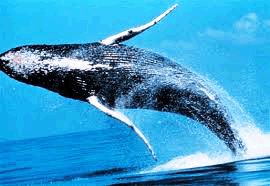Humpback Whale

Common Name: Humpback Whale
Scientific Name: Megaptera novaeangliae
Humpback Whale : Description
Humpback whales are well known for their long "pectoral" fins, which can be up to 15 feet (4.6 m) in length. Their scientific name, Megaptera novaeangliae, means "big-winged New Englander" as the New England population was the one best known to Europeans. These long fins give them increased maneuverability; they can be used to slow down or even go backwards.
Similar to all baleen whales, adult females are larger than adult males, reaching lengths of up to 60 feet (18 m). Their body coloration is primarily dark grey, but individuals have a variable amount of white on their pectoral fins and belly. This variation is so distinctive that the pigmentation pattern on the undersides of their "flukes" is used to identify individual whales, similar to a humans fingerprint.
Humpback Whale : Diet
During the summer months, humpbacks spend the majority of their time feeding and building up fat stores (blubber) that they will live off of during the winter. Humpbacks filter feed on tiny crustaceans (mostly krill), plankton, and small fish and can consume up to 3,000 pounds (1360 kg) of food per day.
Humpback Whale : Behaviour
Humpback whales are the favorite of whale watchers, as they frequently perform aerial displays, such as breaching (jumping out of the water), or slap the surface with their pectoral fins, tails, or heads.
Humpback Whale : Habitat
During migration, humpbacks stay near the surface of the ocean.While feeding and calving, humpbacks prefer shallow waters. During calving, humpbacks are usually found in the warmest waters available at that latitude. Calving grounds are commonly near offshore reef systems, islands, or continental shores.Humpback feeding grounds are in cold, productive coastal waters
Humpback Whale : Life History
Humpbacks are increasing in abundance in much of their range. In the Southern Hemisphere, humpback abundance prior to commercial exploitation is estimated at 100,000 whales. Including illegal unreported Soviet whaling, there were an estimated 200,000 Southern Hemisphere humpback whales harvested from 1904-1980. The current Southern Hemisphere population may be over 25,000 whales although we have little data on which to base this estimate.
In the North Pacific, humpback abundance was estimated at fewer than 1,400 whales in 1966, after heavy commercial exploitation. The current abundance estimate for the North Pacific is about 20,000 whales
Humpback Whale : Special Features or Habits
Humpbacks are found in high latitude feeding grounds such as the Gulf of Maine in the Atlantic and Gulf of Alaska in the Pacific. In the winter, they migrate to calving grounds in subtropical or tropical waters such as the Dominican Republic in the Atlantic and the Hawaiian Islands in the Pacific. The Arabian Sea humpback, however, does not migrate, remaining in tropical waters all year.
Humpback Whale : Location or Region Found
In the western North Atlantic ocean, humpback whales feed during spring, summer, and fall over a range that encompasses the eastern coast of the United States (including the Gulf of Maine), the Gulf of St. Lawrence, Newfoundland/Labrador, and western Greenland. In winter, whales from the Gulf of Maine mate and calve primarily in the West Indies. Not all whales migrate to the West Indies every winter, and significant numbers of animals are found in mid- and high-latitude regions at this time.
 Deep Sea Crabs
Deep Sea Crabs